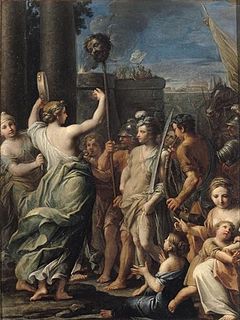
Giuseppe Maria Crespi, nicknamed Lo Spagnuolo, was an Italian late Baroque painter of the Bolognese School. His eclectic output includes religious paintings and portraits, but he is now most famous for his genre paintings.

Domenico Maria Canuti was an Italian painter of the Baroque period, active mainly in Bologna and Rome. He was a major painter of fresco decorations. His ceiling decorations showed a mix of Bolognese and Roman influences.

Piermaria Bagnadore, also called Pietro Maria Bagnatori, was an Italian painter, sculptor, and architect of the late-Renaissance period.

Giacomo Boni was an Italian painter of the late-Baroque period, active mainly in Genoa.
Giovanni Battista Cremonini was an Italian painter of the Renaissance period.

Luigi Quaini (1643–1717) was an Italian painter of the Baroque period.
Giacinto Garofalini (1661–1723) was an Italian painter of the Baroque period, active mainly in Bologna. He was initially a pupil of Donato Creti, then a pupil of the painter Marcantonio Franceschini. Also called Garofolini by Luigi Lanzi. He was an professor at the Accademia Clementina, where he taught figure painting.
Zanobi Poggino of Zanobi di Poggino was an Italian painter, active as a portrait and historical painter in Florence. He was a pupil of Giovanni Antonio Sogliani. While he was noted by Filippo Baldinucci, none of his works could be identified by Luigi Lanzi.

Pasquale Cati was an Italian Mannerist painter active mostly in Rome.
Matteo Bonechi was an Italian painter of the late Baroque period, active mainly in Florence. He trained under Giovanni Camillo Sagrestani. He also executed works in the church of San Frediano in Cestello, in the Oltrarno district of Florence. He also painted for the Palazzo Capponi-Covoni near the Nunziata in Florence.
Giovanni Domenico Brugieri (1678–1744) was an Italian painter of the late-Baroque period in Lucca. Lanzi is cited as referring to him as either Giovanni Domenico or in other places as Giovanni Batista or Battista,.
Giorgio Alberino was an Italian painter, depicting sacred subjects, active in Casale Monferrato in early 17th century.
Giovanni Evangelista Draghi (1654–1712) was an Italian painter of the late-Baroque or Rococo period. Luigi Lanzi erroneously refers to him as Giovanni Battista Draghi, who should not be confused with the composer of the same name.

Jacobello di Bonomo was an Italian painter, active in an early Renaissance style.
Anton or Antonio Maria Fabrizi or Fabrizzi was an Italian painter, active in Perugia and Foligno in a Baroque style.
Matteo Piccione was an Italian painter, active in Rome, as a painter of religious subjects. He was born in Ancona. He is noted by Lanzi to be a collaborator with Giovanni Antonio Spadarini He was an academic in the Accademia di San Luca in 1655. One of his paintings is in San Martino ai Monti, Rome. Mariette's catalogue lists paintings in the style of Veronese and Cesi.

Andrea Mainardi, also known as il Chiaveghino, was an Italian painter of the late-Renaissance period, active in Cremona.
Agostino Castellacci was an Italian painter of the Baroque period.
Mauro Soderini was an Italian painter of the late Baroque period, mainly painting sacred subjects and active in his native Florence.
Sebeto da Verona is a late 14th-century Italian painter, active in both Verona and Padua. Little is known about his biography. The name Sebeto is first bandied by Giorgio Vasari in his Lives of the Painters, however some sources claim the name is derived from De Jebeto, a vulgarization of da Zevio. They claim that such a painter was a pupil of either Francesco Squarcione or Liberale da Verona.











